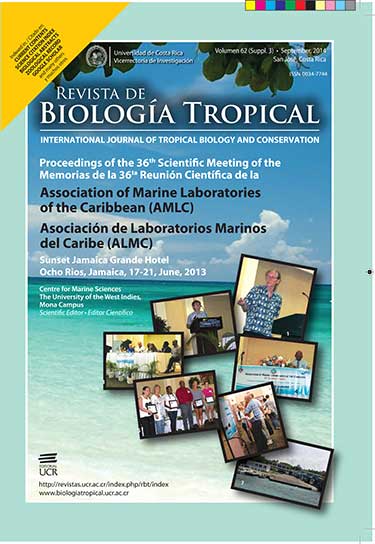Resumen
La reciente invasión del pez león (Pterois volitans) en el Atlántico se considera una nueva amenaza para bentónicos y peces de las comunidades en la región del Caribe. Esta especie fue informada por primera vez en varios sitios de Venezuela en 2009. El aumento de informes en los últimos cinco años sugiere que ha ampliado su distribución y hábitats. Sin embargo, esta información es principalmente anecdótica por lo que son necesarios estudios dirigidos a determinar su abundancia, estructura de tallas y otros aspectos ecológicos que abarquen más escalas espaciales para entender el papel real de esta especie en comunidades marinas en Venezuela. Determinamos la densidad y estructura del tamaño poblacional del pez león a través de censos visuales en la costa venezolana. Realizamos censos visuales siguiendo transectos lineales a una profundidad entre 5 y 20m durante el día, en 19 sitios de cinco localidades. La densidad media varia entre 7 y 55 individuos por hectárea entre sitios. La mayoría de los individuos eran adultos que se encontraban en cuevas, coexistiendo con otro peces león o con diferentes especies; mientras que otros estaban forrajeando activamente. El pez Pterois volitans esta bien establecido a lo largo de la costa venezolana y sus densidades en algunos sitios parecen exceder lo informado para su distribución nativa en el Pacífico pero son densidades menores que las informadas en localidades del Atlántico.
Citas
Albins, M. A. & Hixon, M. A. 2011. Worst case scenario: potential long-term effects of invasive predatory lionfish (Pterois volitans) on Atlantic and Caribbean coral-reef communities. Env. Bio. of Fishes.
Albins, M. & Hixon, M. 2008b. Invasive Indo-Pacific lionfish Pterois volitans reduce recruitment of Atlantic coral-reef fishes. Mar. Ecol. Prog Ser. 367: 233–238.
Anderson, M. J. 2005. Permutational multivariate analysis of variance. Department of Statistics, University of Auckland, Auckland. Retrieved from http://www.stat.auckland.ac.nz/~mja/prog/PERMANOVA_UserNotes.pdf
Côté, I., & Maljkovic, A. 2010. Predation rates of Indo-Pacific lionfish on Bahamian coral reefs. Mar. Ecol. Prog. Ser. 404: 219-225.
Darling, E. S., Green, S. J., O’Leary, J. K., & Côté, I. M. 2011. Indo-Pacific lionfish are larger and more abundant on invaded reefs: a comparison of Kenyan and Bahamian lionfish populations. Biol. Inv. 13(9), 2045-2051.
Fishelson, L. 1997. Experiments and observations on food consumption, growth and starvation in Dendrochirus brachypterus and Pterois volitans (Pteroinae, Scorpaenidae). Env. Bio. of Fishes, 50(4), 397-403.
Ginsburg R., Kramer P., Lang J., Salle P. Steneck R. 1998. Atlantic and Gulf Rapid Reef Assesment (AGRRA). (http://agrra.org).
Green S., N. Tamburello, S. Miller, J. Akins, I. Côté. 2013. Habitat complexity and fish size affect the detection of Indo-Pacific lionfish on invaded reefs. Coral Reefs 32,413-421
Gurevitch, J., & Padilla, D. 2004. Are invasive species a major cause of extinctions? Trends Ecol. Evolut. 19(9), 470-474.
Hamner, R. M., Freshwater, D. W., & Whitfield, P. E. 2007. Mitochondrial cytochrome b analysis reveals two invasive lionfish species with strong founder effects in the western Atlantic. J. Fish Biol. 71, 214–222.
Kulbicki M, Beets J, Chabanet P, Cure K, Darling E, Floeter SR, Galzin R, Green A, Harmelin, Vivien M, Hixon M, Letourneur Y, Lison de Loma T, McClanahan T, McIlwain J, MouTham G, Myers R, O’Leary JK, Planes S, Vigliola L, Wantiez L. 2012. Distributions of Indo-Pacific lionfishes Pterois spp. in their native ranges: implications for the Atlantic invasion. Mar. Ecol. Prog. Ser. 446, 189-205.
Lasso-Alcalá, O., & Posada, J. 2010. Presence of the invasive red lionfish, Pterois volitans (Linnaeus, 1758), on the coast of Venezuela, southeastern Caribbean Sea. Aquatic Invasions, 5(Supplement 1), S53–S59.
Lesser, M. P., & Slattery, M. 2011. Phase shift to algal dominated communities at mesophotic depths associated with lionfish (Pterois volitans) invasion on a Bahamian coral reef. Biol. Invasions. 13(8), 1855-1868.
López-Ordaz, A., Ortaz, M., & Rodriguez-Quintal, J. G. (2009). Trama trófica de una comunidad de peces en una pradera marina en el Caribe Venezolano. Rev. Biol. Trop. 57(4), 963-975.
Ruiz, G. M., Carlton, J. T., Grosholz, E. D., & Hines, A. H. 1997. Global invasions of marine and estuarine habitats by non-indigenous species: mechanisms, extent, and consequences. Amer. Zoo. 37(6), 621-632.
Schofield, P. 2009. Geographic extent and chronology of the invasion of non-native lionfish (Pterois volitans [Linnaeus 1758] and P. miles [Bennett 1828]) in the Western North Atlantic and Caribbean Sea. Aquat. Inv. 4(3), 473-479.
Schofield, P. 2010. Update on geographic spread of invasive lionfishes (Pterois volitans [Linnaeus, 1758] and P. miles [Bennett, 1828]) in the Western North Atlantic Ocean, Caribbean Sea and Gulf of Mexico. Aquat. Inv. 5(Supplement 1), S117-S122.
Whitfield, P. E., Gardner, T., Vives, S. P., Gilligan, M. R., Courtenay Jr, W. R., Ray, G. C., & Hare, J. A. 2002. Biological invasion of the Indo-Pacific lionfish Pterois volitans along the Atlantic coast of North America. Mar. Ecol. Prog. Ser. 235, 289-297.
##plugins.facebook.comentarios##

Esta obra está bajo una licencia internacional Creative Commons Atribución 4.0.
Derechos de autor 2014 Revista de Biología Tropical


